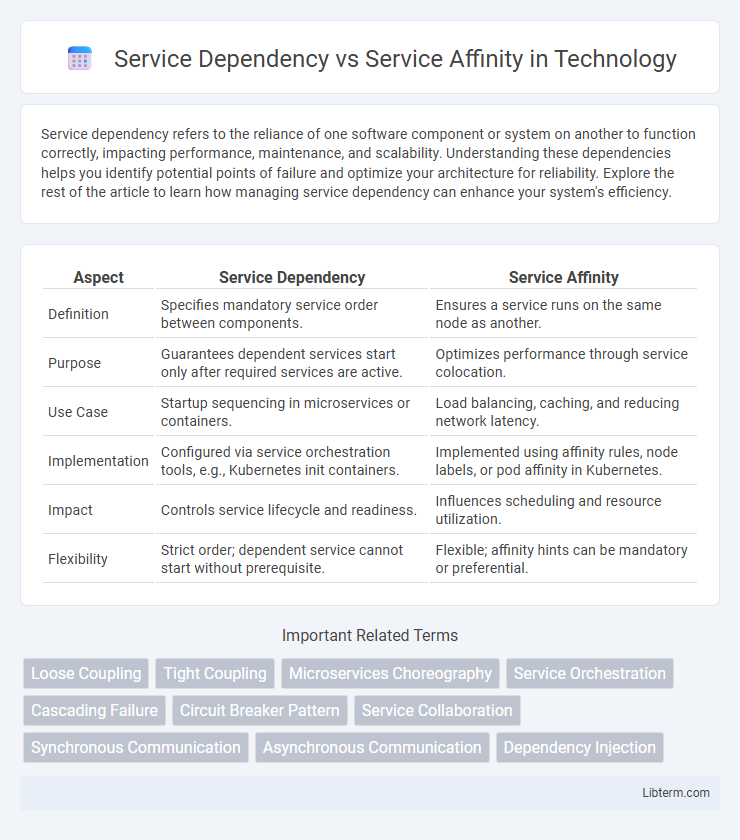Service dependency refers to the reliance of one software component or system on another to function correctly, impacting performance, maintenance, and scalability. Understanding these dependencies helps you identify potential points of failure and optimize your architecture for reliability. Explore the rest of the article to learn how managing service dependency can enhance your system's efficiency.
Table of Comparison
| Aspect | Service Dependency | Service Affinity |
|---|---|---|
| Definition | Specifies mandatory service order between components. | Ensures a service runs on the same node as another. |
| Purpose | Guarantees dependent services start only after required services are active. | Optimizes performance through service colocation. |
| Use Case | Startup sequencing in microservices or containers. | Load balancing, caching, and reducing network latency. |
| Implementation | Configured via service orchestration tools, e.g., Kubernetes init containers. | Implemented using affinity rules, node labels, or pod affinity in Kubernetes. |
| Impact | Controls service lifecycle and readiness. | Influences scheduling and resource utilization. |
| Flexibility | Strict order; dependent service cannot start without prerequisite. | Flexible; affinity hints can be mandatory or preferential. |
Introduction to Service Dependency and Affinity
Service Dependency defines the reliance of one service on another to function correctly, ensuring that dependent services start in the proper order to maintain system stability. Service Affinity refers to the preference or requirement for certain services to run on the same host or within the same environment to optimize performance or resource utilization. Understanding the distinctions between Service Dependency and Service Affinity is crucial for designing efficient and resilient distributed systems.
Defining Service Dependency
Service dependency refers to the reliance of one service on another to function correctly, impacting system architecture and deployment order. It determines how services interact and which services must be available to start or run dependent applications. Understanding service dependency is crucial for orchestrating microservices and managing fault tolerance in distributed systems.
Understanding Service Affinity
Service affinity refers to the practice of directing client requests to the same service instance to maintain session consistency and improve performance in distributed systems. This concept is essential in environments where stateful interactions are critical, such as in web applications requiring user session persistence. Understanding service affinity enables better load balancing strategies and ensures smoother user experiences by minimizing session disruptions.
Key Differences Between Service Dependency and Affinity
Service dependency involves a strict requirement where one service must be available for another to function properly, often causing startup or execution delays if the dependent service is unavailable. Service affinity, on the other hand, refers to the preference for services to run on the same node or close proximity to optimize performance and reduce latency without enforcing strict operational constraints. The key difference lies in dependency dictating functional necessity, while affinity focuses on performance optimization and resource locality.
Real-World Examples of Service Dependency
Service dependency occurs when one service requires another to function properly, such as a payment service relying on an authentication service to validate users before processing transactions. In contrast, service affinity involves directing requests to the same service instance to maintain state, like a shopping cart service that keeps user session data on a specific server. Real-world examples of service dependency include online retailers where the order management service depends on inventory services to check product availability and on shipping services to arrange delivery logistics.
Practical Scenarios for Service Affinity
Service affinity ensures that user sessions consistently connect to the same service instance, which is critical in scenarios like online shopping carts or online gaming where session persistence maintains user state and experience. In contrast, service dependency refers to one service relying on another to function properly, common in microservices architectures where a payment service depends on an authentication service. Practical use of service affinity prevents data loss and session interruptions, optimizing performance in environments requiring session-aware routing such as load balancers in web applications.
Challenges in Managing Service Dependencies
Managing service dependencies presents challenges such as complex inter-service communication, increased risk of cascading failures, and difficulties in maintaining system reliability and scalability. Service affinity complicates resource allocation by requiring specific instances to handle particular services, potentially leading to bottlenecks and uneven load distribution. Ensuring fault tolerance and dynamic adaptability becomes crucial to mitigate downtime and performance degradation in environments with tightly coupled service dependencies and affinity constraints.
Strategies for Handling Service Affinity in Microservices
Service affinity in microservices demands strategies such as sticky sessions or stateful service instances to ensure consistent user experience and data accuracy. Employing session persistence techniques with load balancers or using distributed caches can effectively handle affinity by directing traffic to the same service instance. Optimizing service affinity enhances scalability and reliability while maintaining performance in distributed microservices architectures.
Best Practices for Balancing Dependency and Affinity
Service Dependency should be minimized to reduce tight coupling, enhancing system resilience and scalability, while Service Affinity should be configured to improve local performance and reduce latency by co-locating related services. Best practices involve strategically balancing these by employing loose coupling through asynchronous communication patterns and maintaining affinity within node-level boundaries to optimize resource utilization and fault tolerance. Monitoring metrics like response time and failure rates guides adjustments in dependency reduction and affinity placement to achieve optimal service orchestration.
Conclusion: Optimizing Service Interactions
Optimizing service interactions requires understanding the distinctions between service dependency and service affinity, where dependency emphasizes required service availability and affinity focuses on preferred service co-location for performance gains. Balancing these concepts enhances system resilience, reduces latency, and ensures efficient load distribution. Implementing strategies that consider both dependency constraints and affinity preferences leads to scalable, reliable, and responsive service architectures.
Service Dependency Infographic

 libterm.com
libterm.com